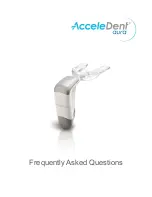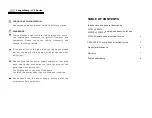
Instruction Manual
www.hannainst.com
Dear Customer,
Thank you for choosing a Hanna Product.
Please read the instruction sheet carefully before using the
test kit. It will provide you with the necessary information
for correct use of the kit. If you need additional information,
do not hesitate to e-mail us at [email protected].
Remove the test kit from the packing material and examine
it carefully to make sure that no damage has occurred
during shipping. If there is any noticeable damage, notify
your Dealer or the nearest Hanna office immediately.
Each kit is supplied with:
• HI 93713-0 Reagent, packets (100 pcs);
• 1 checker disc (containing the
38073
disc);
• 2 glass vials with caps;
• 1 plastic pipette (3 mL).
Note:
Any damaged or defective item must be returned in
its original packing materials.
HI 38077
Phosphate
Test Kit for
Irrigation Water
ISTR38077 02/00 PRINTED IN ITALY
Phosphorus occurs in natural waters and in wastewaters almost
entirely as phosphates. Large quantity of phosphate arise from
laundering industries as it is used in many cleaning prepara-
tions, from soil runoff and sewage.
Phosphorus is essential to plants since it contributes to the
formation of buds, roots and blooming as well as lignification
and its lack results in stifled plants or pale green color with
reddish pigmentation on leaves' edges.
On the other hand, an extensive discharge of phosphorus in
water is the major cause of eutrophication, which is an
abnormal and excessive growth of aquatic plants.
Note:
mg/L is equivalent to ppm (parts per million).
SPECIFICATIONS
SPECIFICATIONS
SPECIFICATIONS
SPECIFICATIONS
SPECIFICATIONS
SIGNIFICANCE AND USE
SIGNIFICANCE AND USE
SIGNIFICANCE AND USE
SIGNIFICANCE AND USE
SIGNIFICANCE AND USE
CHEMICAL REACTION
CHEMICAL REACTION
CHEMICAL REACTION
CHEMICAL REACTION
CHEMICAL REACTION
INSTRUCTIONS
INSTRUCTIONS
INSTRUCTIONS
INSTRUCTIONS
INSTRUCTIONS
Adaptation of the ascorbic acid method. The reaction be-
tween phosphate and the reagent causes a blue tint in the
sample.
READ THE ENTIRE INSTRUCTIONS BEFORE USING THE KIT
• Using the pipette, add to each
glass vial 7.5 mL of sample (up
to the mark).
• Insert one of them into the left hand opening of the
checker disc. This is the blank.
• Add to the other glass vial 1 packet of HI 93713-0
Reagent. Replace the cap and shake vigorously for 20
seconds. This is the reacted sample.
• Wait for 3 minutes.
• Remove the cap and insert the reacted sample into the
right hand opening of the checker disc.
• Hold the checker disc so that a
light source illuminates the
samples from the back of the
windows.
• Keep the checker disc at a distance of 30-40 cm (12-
16") from the eyes to match the color. Rotate the disc
while looking at the color test windows and stop when
you find the color match. Read the value in the result
window, divide it by 10 and record it in mg/L (or ppm)
Range
0 to 5 mg/L (ppm) Phosphate (PO
4
3-
)
Smallest Increment
0.1 mg/L (ppm) Phosphate
Analysis Method
Colorimetric
Sample Size
7.5 mL
Number of Tests
100
Case Dimensions
235x175x115 mm (9.2x6.9x4.5")
Shipping Weight
429 g (15.1 oz.)
The chemicals contained in this kit may be hazardous if
improperly handled. Read the relevant Health and Safety
Data Sheet before performing this test.
HEALTH AND SAFETY
HEALTH AND SAFETY
HEALTH AND SAFETY
HEALTH AND SAFETY
HEALTH AND SAFETY
REFERENCES
REFERENCES
REFERENCES
REFERENCES
REFERENCES
APHA, AWWA, WEF,
Standard Methods for the Examina-
tion of Water and Wastewater
, 18
th
edition, 1992
7.5 mL
of Phosphate. To convert this result to mg/L (ppm) of
Phosphorus, divide it by 3,1.
For best results:
Perform the reading three times and take
the average value (divide by 3 the sum of the three
numbers). Intensely colored samples will make the color
matching determination difficult and they should be
adequately treated before performing the test. Sus-
pended matter in large amounts should be removed by
prior filtration.
Caution:
Ultraviolet radiation may cause fading of colors.
When not in use, keep the disc protected from light,
in a cool and dry place.
Interferences:
iron above 5 ppm; copper above 10 ppm;
hydrogen sulfide, arsenate and highly buffered
samples.



















